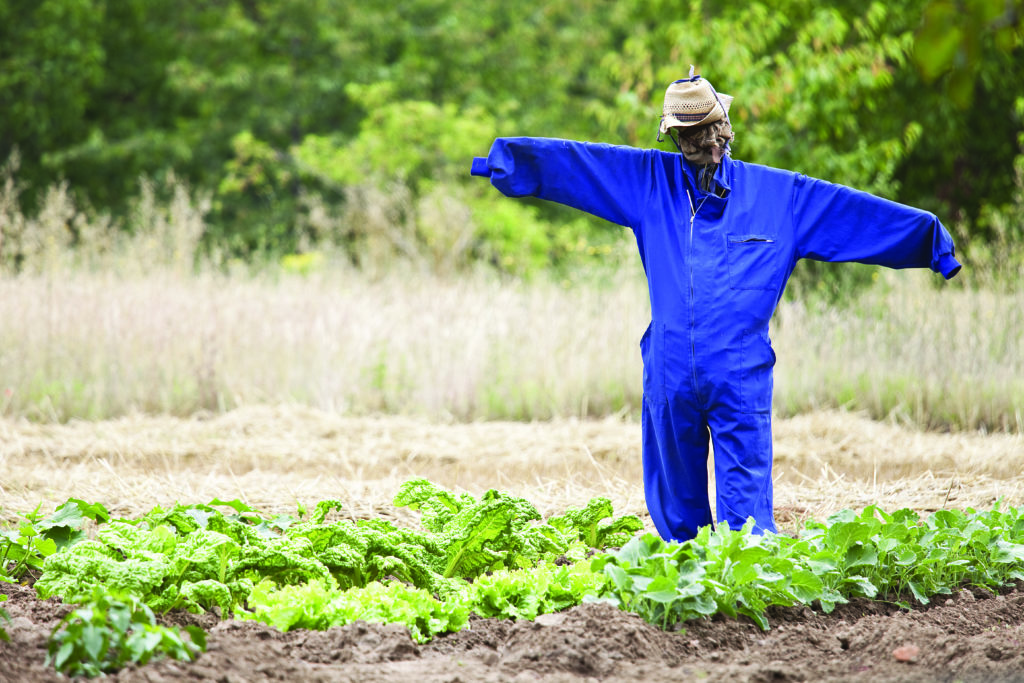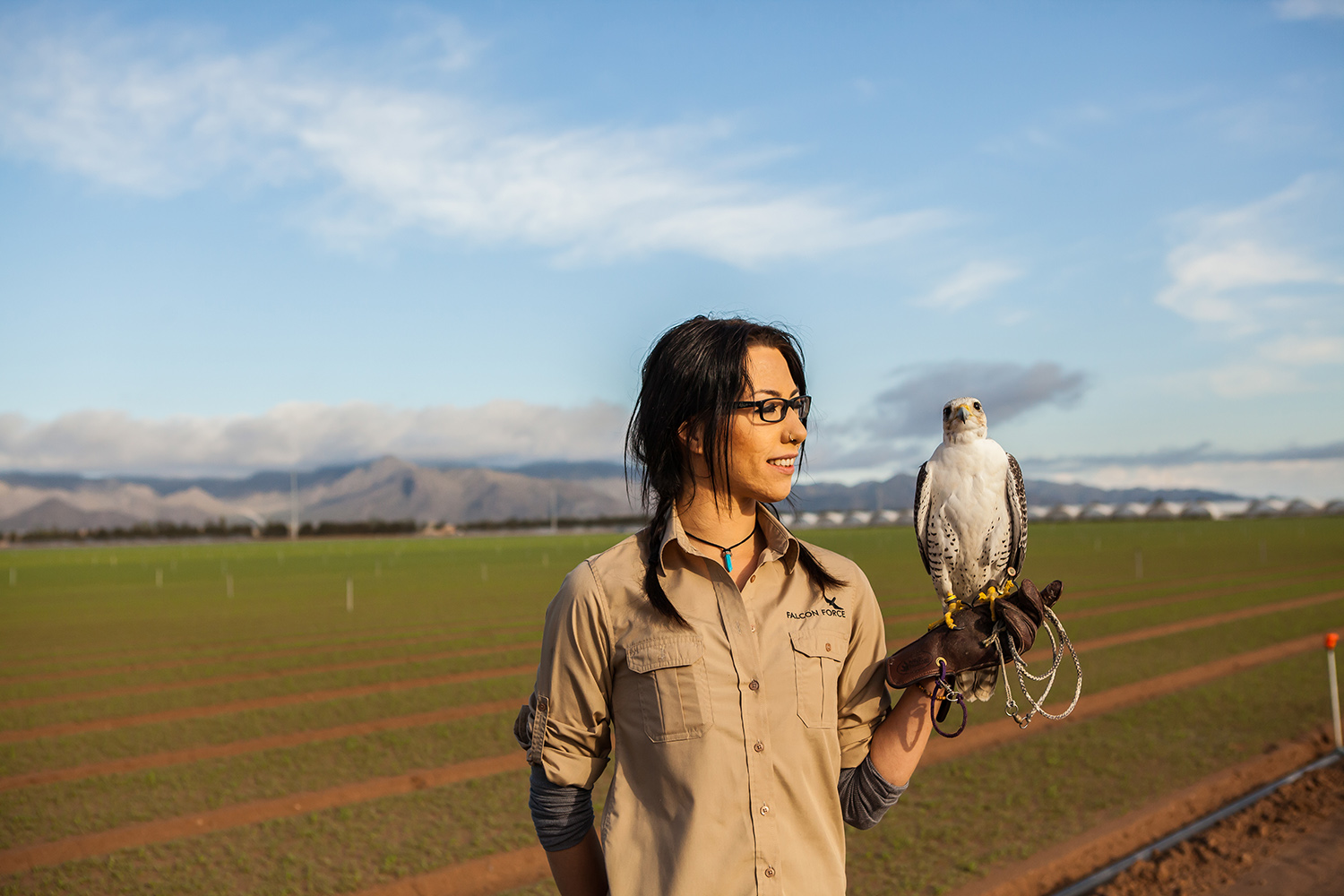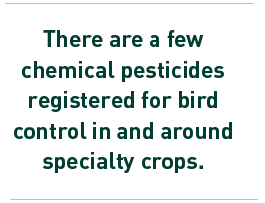

Nov 7, 2018Some tips to curb bird damage in specialty crops
Vegetable growers deal with a large number of disease, insect and weed pests, which they control with varying levels of satisfaction through cultural, mechanical or chemical means. A unique group of pests that continues to frustrate many specialty crop growers is wildlife – especially birds.
Many bird species are valuable natural resources to be preserved and they provide valuable ecosystem services to farmers, such as eating insect pests, which makes targeted management even more critical. Controlling birds is becoming more important as many bird populations grow and issues such as food safety gain attention. Fencing and netting of various types can exclude many birds, but this approach is not always practical. Other tactics rely on manipulating bird behavior, though not all birds behave the same. Flocking birds like starlings descend in large numbers eating small fruit whole or slashing and pecking at larger fruit. Crows come in smaller family units, usually with an assigned “sentinel.”
Both can cause significant damage – one from sheer numbers, the other from large size and social intelligence. The other frustration is they do not finish one fruit and move to the next – they partially damage many, making them all unsalable.
Bird habitat and behavior
Bird damage is more likely to reach economic threshold where birds are numerous, feel at ease and have access to desirable crops. Damage is generally concentrated in areas where bird habitat and susceptible crops adjoin. Small fields and orchard blocks with a higher edge-area ratio are more susceptible, and damage is usually worse when neighboring food sources are scarce or compromised.
Crops themselves provide varying levels of habitat suitability for birds. Planting date and crop maturity, alone or relative to neighboring fields, is usually important. Controlling early damage is often more beneficial since if you can keep them out long enough they will find other food sources and may not return to your crop. Damage usually picks up as crops ripen, turn color and approach maturity. Recent research at Cornell University has documented success with detasseling sweet corn to discourage perching and feeding.
Some birds are migratory, while others can be territorial, and these can shift with the season. Identifying which species are causing damage, learning how their lifecycle and habitat preferences intersect with crop production practices is critical to predicating and preventing crop damage. Focus control efforts in crops, field areas, and at times of the year when damage probability is highest. Leverage bird behavior to your advantage by thinking like a bird.
Visual scare tactics are likely the oldest methods of deterrence, but recently this approach has expanded with new technology. In days past, it was often the job of the youngest family members to chase birds away from crops. However, keeping children on-guard in the field is rarely an option today and birds (especially crows) quickly learn human patterns and just wait for people to leave before descending. Enter the scarecrow that will work on your behalf at low pay while you are gone! Scarecrows do not move much, so it only takes a short time for most birds to realize this thing that kind of looks like a person is not much of a threat, and in fact makes a good perch.
Some growers report success with stationary fake owls or balloons and kites that look like swooping raptors. Owls and crows do not get along very well, probably because owls rob crows’ nests. So when crows see an owl they either leave or attack it en masse. Many songbirds are wary of raptors, especially hawks and falcons. Predator bird effigies need to be placed high enough off the ground to be considered a threat. Even when placed high (above 20 feet is best), effigies have a maximum effective radius and more than one may be required. A biocontrol alternative to predator bird effigies is installing perches and improving habitat to encourage real owls and raptors. Though rarely feasible, commercial falconry can also be effective.


A related visual method many old-time farmers swear by for controlling crows is a dead crow effigy. We have learned from experience that this does work, but the challenge is getting close enough to a wily crow to shoot one. If you do get one (or more) and hang it near a susceptible crop, other crows will stay away. This works for about a 200-foot radius and then you will need another dead crow. They seem to know the difference between a dead crow and a black plastic bag that to us looks like a dead crow.
The latest technologies in visual deterrents include air dancers and lasers. Air dancers are tall fabric, inflated tubes that moved by a fan to provide constant motion. They can be effective in the short term, but require a power source and should be moved to prevent habituation. Lasers are placed on a rotating platform, creating a 360-degree intermittent and disorienting light pattern. This approach is most effective in low light, and does not work well in hilly fields or foggy conditions since both cut short the lasers. The other problem is, just like the scarecrow, birds can get used to them.
The audio approach
Various devices have been developed that either make generally frightening noises, or more specifically mimic predator or bird distress calls. The simplest of these is probably a farmer with a shotgun or cracker pistol, but this again requires labor, so propane cannons were developed. Propane-powered cannons emit a bang by sparking off propane in a long barrel. These can be set to go off at varying or random intervals. Some even spin so it appears the sound is coming from a different direction with each bang. The problem with these is that your neighbors also hear them. Here too, is the scarecrow syndrome – birds eventually get used to loud sounds, though moving them daily around your fields seems to help.
Electronic predator and bird distress calls are the most technologically advanced methods of audio deterrence. Have you ever been in the garden center of a big box store and heard squawking bird sounds? These bio-acoustic tools can be effective since they rely on biologically relevant audio signals to trigger a bird’s instinctual flight response. Bio-acoustic tools do require electricity and amplification, and must be specifically designed for the bird species you are attempting to control. They also have a limited effective radius based on amplification capability and the potential human annoyance.
Some control devices are visual and audio in nature. The lowest tech combined tool is flashing aluminized tape. This twists in the wind, reflecting the sun, and achieves an effect similar to lasers. It is also stiff enough to make a crinkling sound when windblown. Other light objects like plastic bags can create similar audio-visual effects. Their shortcomings are noticed on cloudy, windless days, but these can be useful, low-cost options.
The use of remote control aircraft to scare away birds is not new, but recent developments in unmanned aerial vehicles (UAVs) have made this approach more practical. UAVs have inherent visual and audio properties capable of frightening birds, which can be enhanced to make it look like a predator and/or on-board bioacoustics. Unlike stationary devices, squawking and humming UAVs can direct birds away from sensitive areas. Although UAVs can be effective, they are also expensive to purchase and operate. Current UAV regulations require the operator to be able to observe the drone at all times and pilots are required to have a Federal Aviation Administration license if flying for commercial purposes. Many states have passed laws prohibiting wildlife scouting, harassment or taking of game with UAVs.
The chemical approach
There are a few chemical pesticides registered for bird control in and around specialty crops. Methyl anthranalate, which is sold under the name Avian Control and similar to artificial grape flavoring, can be sprayed to protect many fruit, vegetable and grain crops. It can reduce bird damage through odor and taste repellency, but must be applied before crops ripen and are discovered by birds. It also needs to be reapplied after rain, and applicators should be cautious close to harvest since it may impart flavor to the crop they are protecting.
4-aminopyridine, the active ingredient in Avitrol baits, is an acute oral toxicant, which acts on the central nervous system and motor nervous system of birds. Licensed pesticide applicators can deter birds by strategically placing treated bait in areas isolated from non-targets but accessible to birds. The idea here is to cause an adverse physical reaction in a few birds to scare away the rest, but it can have prolonged and often fatal effects.
Controlling bird damage in specialty crops requires attention to regulations, bird habitat and behavior, and a suite of modern integrated control tools. To learn more about bird damage management in tree fruit and sweet corn, attend the Wildlife Damage Management session at the Great Lakes Fruit, Vegetable & Farm Market EXPO in Grand Rapids, Michigan, scheduled for Dec. 6, 9-11 a.m.
This session will be an opportunity to interact with researchers from Michigan State University and Cornell University, as well as representatives from USDA Wildlife Services and Michigan Department of Natural Resources. VGN
– Ron Goldy and James DeDecker, Michigan State University
















